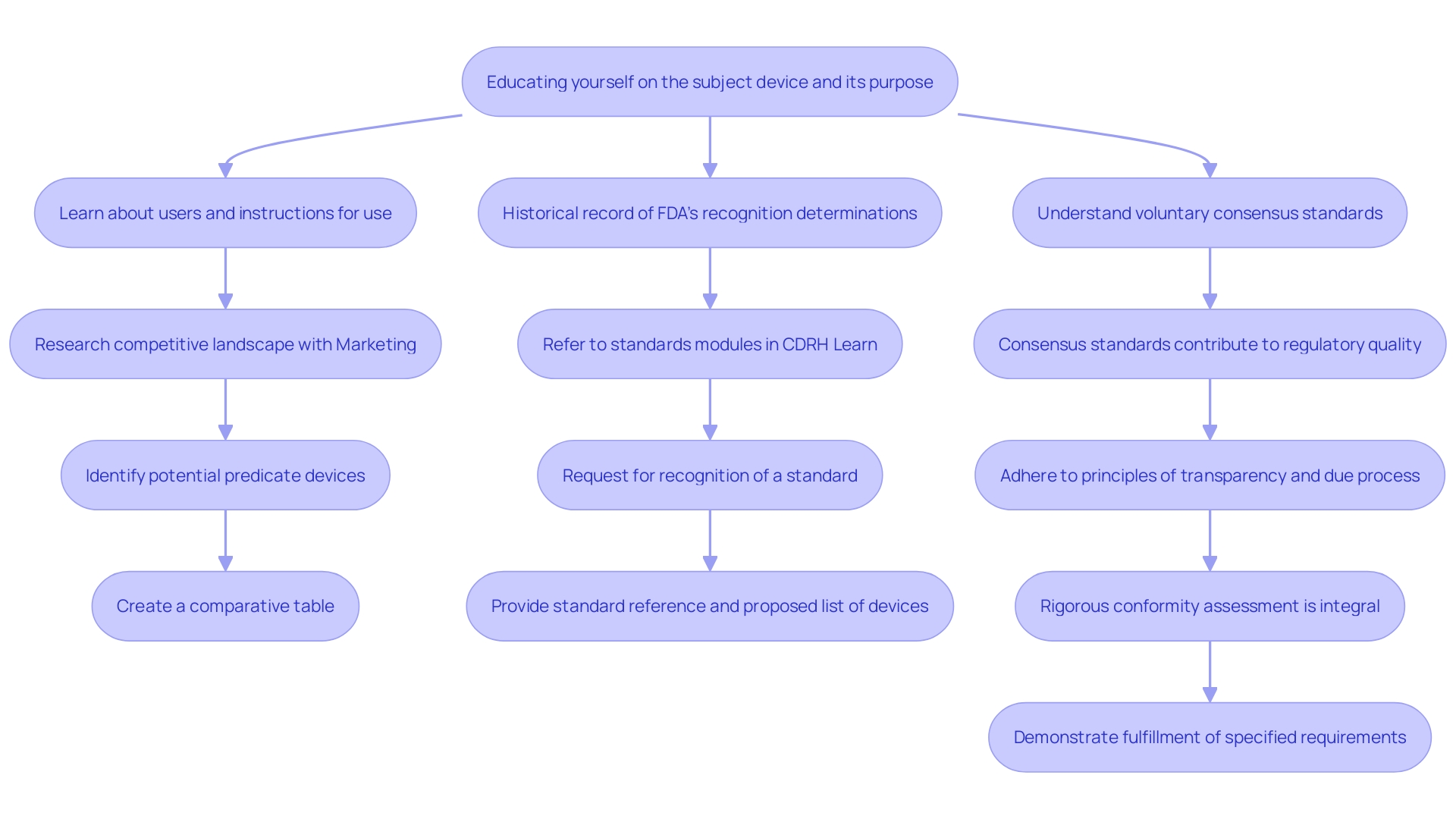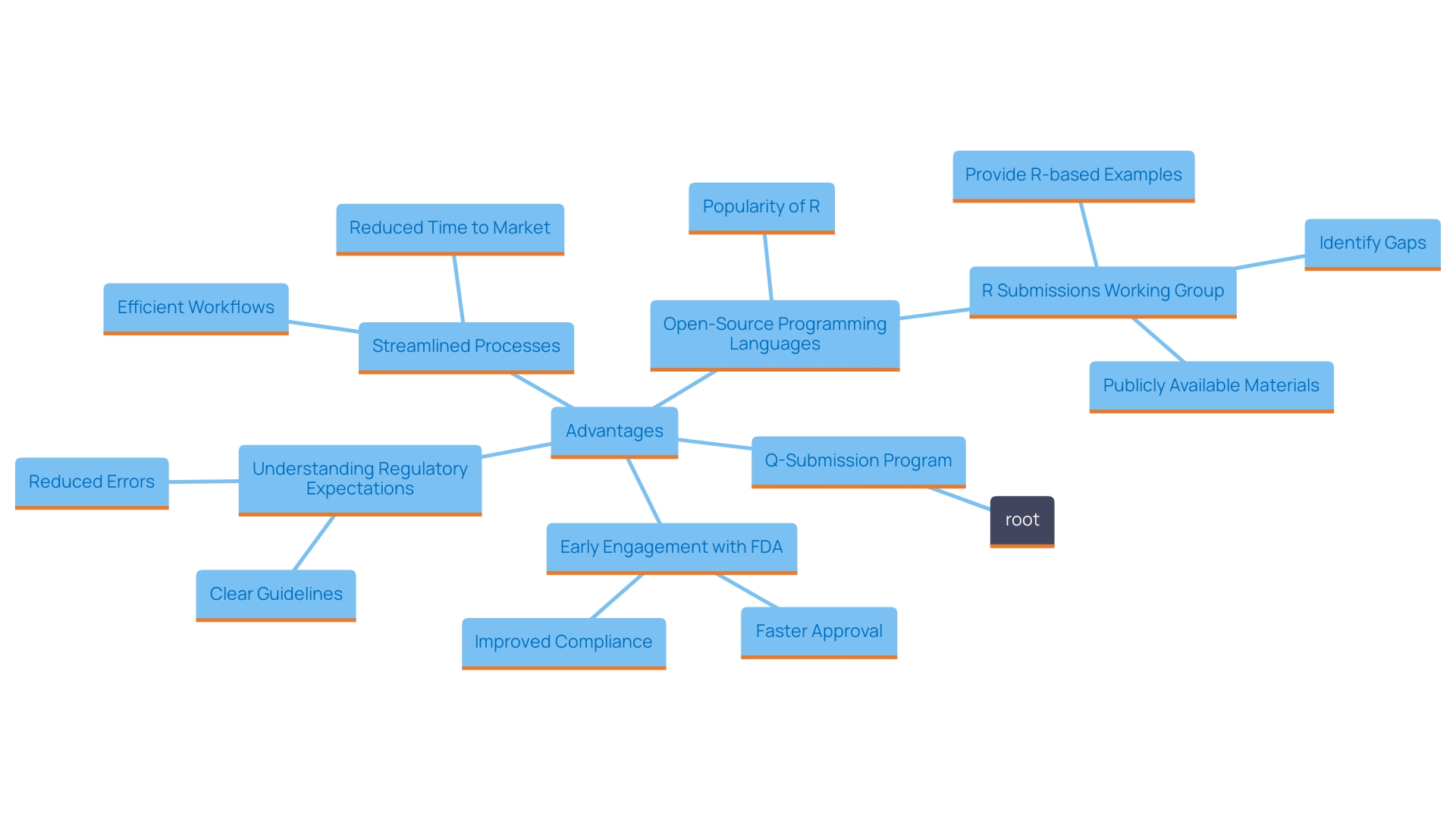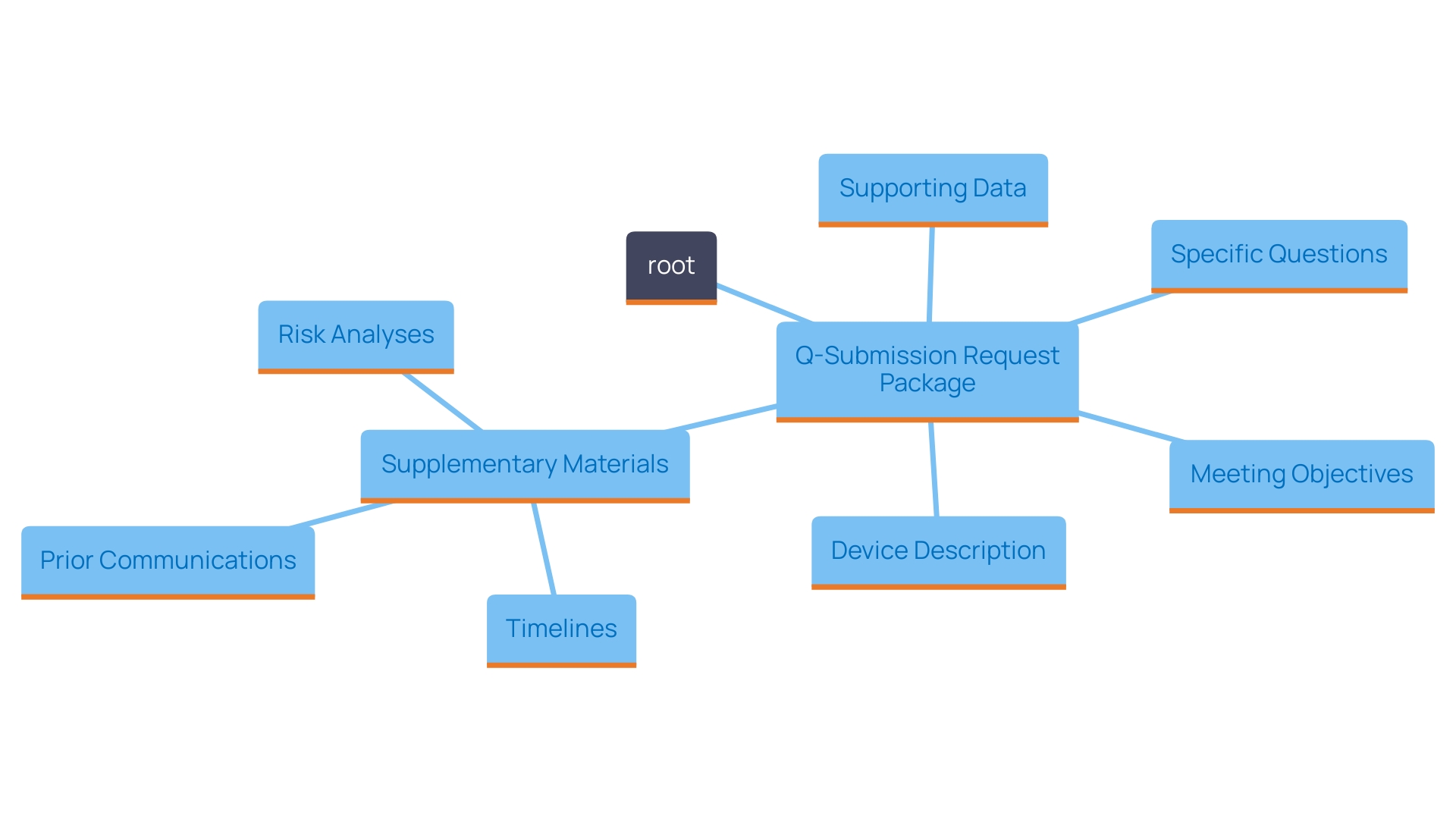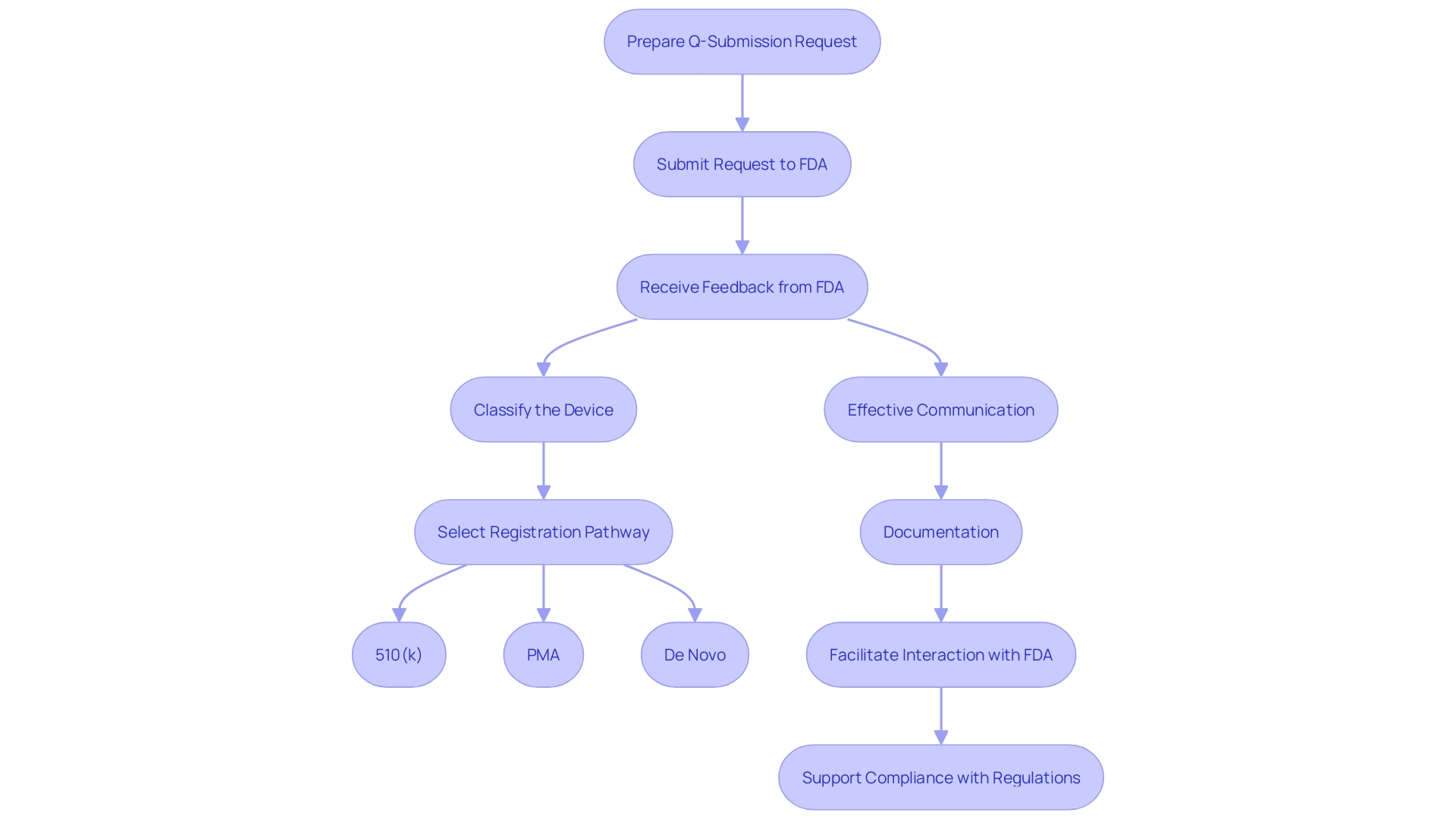Introduction
The Q-Submission program, established by the FDA, serves as a vital tool for facilitating early and constructive interactions between medical device sponsors and regulatory officials. By promoting open dialogue, this initiative not only clarifies the feedback mechanisms available but also streamlines the submission process, ultimately enhancing compliance with regulatory standards. The structured framework outlined in the FDA's draft guidance, titled “Requests for Feedback and Meetings for Medical Device Submissions: The Q-Submission Program,” delineates various types of interactions that can significantly impact the regulatory pathway for medical devices.
This proactive approach empowers sponsors to make informed decisions and align their development strategies with FDA expectations, thereby paving the way for innovation in medical technology. As stakeholders are encouraged to contribute to the ongoing refinement of this guidance, understanding the nuances of Q-Submission becomes increasingly essential for navigating the complexities of medical device regulation.
What is Q-Submission and Its Purpose
'This process represents a crucial system created by the FDA, allowing sponsors to participate actively in the medical equipment development procedure.'. By allowing for early interactions, this program facilitates a two-way dialogue between sponsors and the FDA, which can significantly influence the regulatory pathway of a medical device. The submission process is designed to clarify the types of feedback available and streamline communication, thus minimizing the risk of misunderstandings during the submission phase.
The draft guidance titled "Requests for Feedback and Meetings for Medical Device Submissions: The Program" outlines the different types of interactions that sponsors can pursue. This guidance aims to clarify how sponsors can effectively obtain feedback from the FDA, distinguishing between informal communications, Pre-Submissions, and other submission types. This structured approach not only enhances the clarity of the submission process but also empowers sponsors to make informed decisions based on FDA insights.
Moreover, the context of use (COU) for computational models is integral to the Q-Submission framework. It outlines how model outputs can tackle specific inquiries of interest, directing the submission process. By meticulously describing these questions and the role of the model, sponsors can ensure that their submissions are well-founded and aligned with FDA expectations.
As the FDA continues to refine its guidance, it is essential for stakeholders to actively participate by submitting comments on the draft guidance. The agency has established a deadline of May 14, 2024, for comments, highlighting the significance of community input in shaping effective governance processes. This proactive involvement can lead to a more robust and transparent oversight environment, ultimately paving the way for innovations in medical technology.

Benefits of Using Q-Submission for FDA Compliance
The Q-Submission program presents significant advantages for ensuring FDA compliance in medical device development. By engaging early with FDA officials, developers can identify potential compliance challenges before they escalate. This proactive interaction fosters a deeper understanding of FDA expectations, thereby enabling companies to tailor their development strategies to align closely with regulatory requirements.
For instance, the draft guidance from the FDA titled "Requests for Feedback and Meetings for Medical Device Submissions: The Program" highlights the mechanisms available for submitters to interact with the FDA. This guidance aims to clarify the types of Q-Submissions and how to obtain feedback for various inquiries, enhancing communication between sponsors and the agency.
Moreover, utilizing this submission method can streamline the process, significantly shortening the time to market. As the pharmaceutical industry increasingly adopts open-source programming languages like R for data submissions, this approach can further enhance efficiency. The R Submissions Working Group is actively addressing the hesitance among sponsors to use these languages by providing working examples and identifying gaps in submission processes. Such initiatives not only promote innovation but also improve collaboration with regulatory bodies, which is crucial for achieving successful market access.
In summary, the advantages of implementing a specific submission strategy are clear: it leads to more efficient submissions, fosters better alignment with FDA requirements, and ultimately enhances outcomes for sponsors and patients alike.

Components of a Q-Submission Request Package
A robust Q-Submission request package is essential for effective interaction with the FDA regarding medical equipment submissions. Key components of this package should include:
- Device Description: A detailed account of the device, including its intended use, technological characteristics, and any differentiating factors that set it apart from existing products.
- Meeting Objectives: Clearly articulated objectives for the meeting, ensuring that the purpose aligns with the type of feedback sought from the FDA.
- Supporting Data: Relevant data that underpins the development process, including results from clinical studies, design validations, and risk assessments. This can help demonstrate the apparatus's safety and effectiveness.
- Specific Questions: Precise questions that the sponsor wishes to address during the meeting should be outlined to facilitate focused discussions.
Additionally, including supplementary materials can enhance the context of the submission:
- Timelines: A roadmap detailing the project milestones and expected timelines can provide the FDA with insight into the developmental progress.
- Risk Analyses: A thorough analysis of potential risks associated with the device can demonstrate the sponsor's commitment to patient safety and regulatory compliance.
- Prior Communications: Any previous correspondence with the FDA should be included to ensure continuity in discussions and to provide background context.
The FDA's draft guidance titled "Requests for Feedback and Meetings for Medical Device Submissions: The Program for Submissions" emphasizes the importance of these elements. This guidance clarifies how to obtain feedback for various types of inquiries and delineates the Q-Submission types. As outlined in the guidance, it is crucial for sponsors to educate themselves about their products, including the competitive landscape and relevant predicate products, to better inform their submissions. Furthermore, the guidance is presently accessible for public feedback until May 14, 2024, enabling stakeholders to assist in its completion, thereby promoting a collaborative framework.

Common Misconceptions and Best Practices for Q-Submission
The process of early regulatory consultation is frequently misinterpreted, with some thinking it ensures FDA clearance or that it is solely applicable to complex products. In reality, the service covers a wide range of medical devices, offering essential support throughout the approval process. It is essential to recognize that while this process can facilitate communication with the FDA, it does not replace comprehensive regulatory preparation.
To maximize the benefits of Q-Submission, it is vital to prepare a meticulous request that clearly outlines the objectives of the submission. This involves identifying the proper classification of the item, which the FDA categorizes into three levels, each associated with different risk profiles. Once the classification is established, the appropriate registration pathway must be selected—be it Premarket Notification (510(k)), Premarket Approval (PMA), or the De Novo process. Each pathway has distinct requirements that must be adhered to before a device can be marketed legally in the U.S. As professionals in the field often note, understanding terms like Registered, Cleared, Approved, and Granted is crucial, as these distinctions significantly impact the oversight landscape.
Effective communication during the Q-Submission process is paramount. Participating in clear conversation with the FDA can help clarify guidelines and streamline the approval process. Furthermore, thorough documentation of meeting outcomes is essential, as it not only aids in planning future actions but also fosters a transparent relationship with the regulatory body. This proactive approach is becoming more essential as medical equipment regulations evolve, with industry leaders recognizing adherence as a top priority amid growing complexity in legislation.
In recent discussions surrounding the FDA's draft guidance on Q-Submission, it has been emphasized that this program offers multiple avenues for feedback and interaction with the agency. As the medical device field becomes more competitive and complex, leveraging these opportunities can significantly enhance a company's ability to navigate FDA requirements effectively.

Conclusion
The Q-Submission program established by the FDA serves as a crucial mechanism for facilitating early and constructive interactions between medical device sponsors and regulatory officials. By promoting proactive dialogue, this initiative enables sponsors to clarify feedback mechanisms and streamline the submission process, ultimately enhancing compliance with regulatory standards. The structured framework provided in the FDA's draft guidance delineates various types of interactions that can significantly influence the regulatory pathway for medical devices.
Engaging early with the FDA through Q-Submission offers substantial benefits, including the identification of potential regulatory challenges and the alignment of development strategies with FDA expectations. This proactive approach not only reduces the time to market but also fosters innovation in medical technology. By meticulously preparing a Q-Submission request package that includes essential components such as device descriptions, meeting objectives, and supporting data, sponsors can enhance their likelihood of successful interactions with the FDA.
Addressing common misconceptions about Q-Submission is vital for maximizing its effectiveness. While some may believe that participation guarantees FDA approval, it is important to recognize that this program is designed to provide guidance rather than replace thorough regulatory preparation. By understanding the nuances of device classification and maintaining clear communication with the FDA, sponsors can navigate the complexities of medical device regulation more effectively.
In summary, the Q-Submission program represents a valuable tool for medical device sponsors, fostering a collaborative regulatory environment that supports innovation and compliance. Engaging actively with the FDA and leveraging the opportunities presented by this framework can lead to more efficient submissions and better outcomes for both sponsors and patients.




